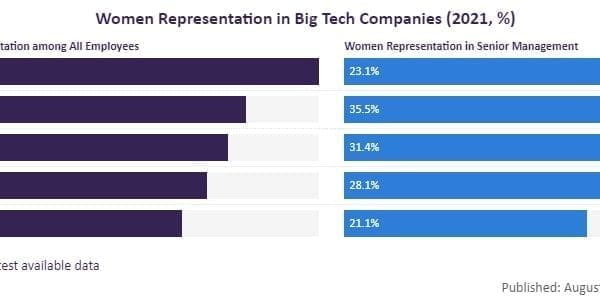GENDER DIVERSITY IN TOP TECH COMPANIES
Contents
- An overview
- Let’s talk about gender disparity statistics
- What is my chance of getting a job at one of the biggest tech companies?
- The Discrimination is Real
- Conclusion
An overview
Over time, there has been a transition from the subject of gender inclusivity to gender diversity and inequality. It is no secret that women are underrepresented in the business world, not excluding the tech industry. The fight for gender inclusivity definitely did not begin in one day and has, in fact, been in existence for quite some time with the “women’s liberation movement.” In recent years, there have been efforts put in place to dissolve this disparity, which has yielded results but show a slow rate of progress. The argument over the cause of gender inequality has remained one that yields no clear-cut result. Take Nigeria, for example, where gender disparity arises from numerous angles, one of them being traditional and religious beliefs. This simply means that every region or group in the world has its own absurd idea of the roles women should play in our society today.

Let’s talk about gender disparity statistics.
According to Exploding Topic’s 2022 report on the statistics of women in tech, 26.7% hold tech-related jobs, with the percentage of women in tech having decreased exponentially over the last two years. While most big tech companies promote a scheme of unbiased hiring and training, statistics show a 2.1% decrease between 2020 and 2022 in the representation of women in such companies.
Even with this substantial percentage of women in tech, only 10% of those attain professional roles as CEOs, and yet we are made to believe that gender equality is on the verge of being attained with the average female tech CEO receiving a pay cut of an average of 27% while the salaries of the men rose by 1%. How is that in any way “equality”?
The recruitment and hiring process is another warzone of its own; it’s definitely not rocket science that women are seen as liabilities to companies and the male species is given more privileges during hiring because of this flawed ideology circulating around the responsibility of a woman as a mother and a “housekeeper.” 48 percent of women in tech report having undergone some form of discrimination in the recruitment or hiring process.
While women are still struggling to attain well-paying roles in the tech industry, the percentage of women who have attained such roles faces a disparity in pay in relation to males working in the same position. A survey of 10,000 tech companies in 2016 recorded a huge pay gap for women in tech according to age, ethnicity, education, geographical location, and department in relation to their male counterparts, with 22% more likely to experience imposter syndrome. Latest reports show that in tech, 91.1% of companies pay their male employees more than their female staff. This puts the tech industry’s gender pay gap at 16%, higher than the national average of 11.6%.
What is my chance of getting a job at one of the biggest tech companies?
Here are some of the statistics from the 2021 Diversity Report from some of the top tech companies in the world today:
Apple: Women make up 34.8% of the workforce and 23% of technical positions.
Google: Women make up 33.5% of the workforce and 28.5% of technical positions.
Facebook: Women make up 39.5% of the workforce and 23% of technical positions.
Microsoft: Women make up 29.7% of the workforce and 20.8% of technical positions.

As a woman of color, I have a 6% chance out of 30.9% of being a new hire at any one of these companies.
The Discrimination is Real
Have you ever heard about the decline in the percentage of men in the tech industry?
Why are women laid off from their positions with more ease than men today? Discrimination against women in the tech industry is a widely reported issue that exists in almost every workplace. Women in the work field today face different forms of discrimination that lead to them either quitting or questioning their abilities this includes;
- Gender Bias and stereotyping: Women are often stereotyped as being less technically proficient in their jobs than men and are subjected to biases in hiring, promotion, and performance evaluations.
- Harassment: Women face a higher chance of harassment in their workplace than men. They reside in a setting where they must constantly worry about encountering this, which has a negative impact on their work output and future employment opportunities.
- Lack of representation and support: Women do not receive the same level of mentorship, networking, and training opportunities as men. If they try too hard, they are considered over-ambitious with disregard to the fact that they are placed in an environment where it is the only thing they can do to survive and meet ends.
- Lack of work-life balance: This is one of the major issues women face as they are expected to have a balance between work and catering for their families.

Conclusion
Does gender inequality still have a place in society?
The gender gap in top tech companies remains a significant issue in the industry. Despite some progress being made, with companies introducing policies aimed at increasing diversity and inclusion, there is still a long way to go. It is particularly alarming that there are so few women in leadership roles, especially in technical fields, as it suggests that women are not welcome at the table when deciding how the industry will develop. It is important that tech companies continue to prioritize diversity and inclusion, not just as a matter of social responsibility but also as a strategic advantage. By building more inclusive workplaces that foster diversity of thought and perspective, companies can tap into the full potential of their talent pool and drive innovation and growth. Ultimately, a more diverse and inclusive tech industry will benefit everyone.


